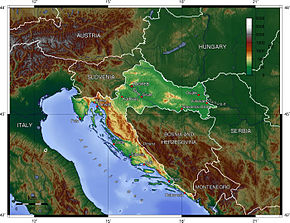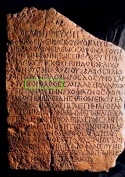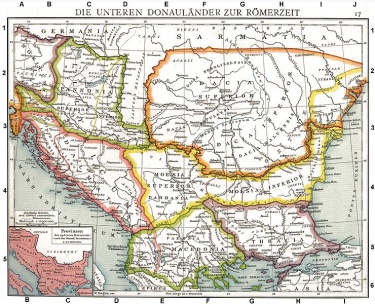Difference between revisions of "Croatian Identity"
(External Links) |
(corrections - fine tune) |
||
| Line 1: | Line 1: | ||
[[File:290px-Croatia topo.jpg|thumb|right|425px| Croatia (Hrvatska)]] | [[File:290px-Croatia topo.jpg|thumb|right|425px| Croatia (Hrvatska)]] | ||
| − | The first primary source, factual to mention the [[Croatia|Croatian]] (Hrvat) identity in the Balkans was ''' | + | The first primary source, factual to mention the [[Croatia|Croatian]] (Hrvat) identity in the Balkans was '''Duke Branimir''' (Latin:'' "Branimiro comite dux cruatorum cogitavit"'' c. 880 AD).<ref>[http://mq.academia.edu/DanijelDzino/Papers/163667/Becoming_Slav_Becoming_Croat_New_approaches_in_research_of_identities_in_post-Roman_Illyricum Becoming Slav, Becoming Croat: New approaches in research of identities in post-Roman Illyricum] by Danijel Dzino |
| − | *"The first evidence of the Croat name, dux/rex Croatorum, does not appear until the ninth century. The Charter of Duke Trpimir is indeed the oldest text that mentions the Croat name, dux Chroatorum but its authenticity is disputed for good reason. The earliest certain evidence is the title dux Cruatorum from duke Branimir's inscription (c. 880), so that before this date we cannot assume with certainty that the Croat identity existed at all."</ref><ref>[http://books.google.com.au/books?id=EqNiAAAAMAAJ&q=BRANIMIRO+COMITE+DUX+CRUATORUM+cogitavit&dq=BRANIMIRO+COMITE+DUX+CRUATORUM+cogitavit&hl=en&ei=MljwTfHIIoyKuAOO3_WhBA&sa=X&oi=book_result&ct=result&resnum=1&ved=0CC4Q6AEwAA A History of the Croatian Language:] by Milan Mogus (p.13)</ref> | + | *"The first evidence of the Croat name, dux/rex Croatorum, does not appear until the ninth century. The Charter of Duke Trpimir is indeed the oldest text that mentions the Croat name, dux Chroatorum but its authenticity is disputed for good reason. The earliest certain evidence is the title dux Cruatorum from duke Branimir's inscription (c. 880), so that before this date we cannot assume with certainty that the Croat identity existed at all."</ref><ref>[http://books.google.com.au/books?id=EqNiAAAAMAAJ&q=BRANIMIRO+COMITE+DUX+CRUATORUM+cogitavit&dq=BRANIMIRO+COMITE+DUX+CRUATORUM+cogitavit&hl=en&ei=MljwTfHIIoyKuAOO3_WhBA&sa=X&oi=book_result&ct=result&resnum=1&ved=0CC4Q6AEwAA A History of the Croatian Language:] by Milan Mogus (p.13)</ref> Duke Branimir was a '''Slav''' from Dalmatia. |
A group of Slavic <ref>[http://books.google.com.au/books?id=6UbOtJcF8rQC&pg=PA195&dq=Becoming+Slav,+Becoming+Croat+Identity+Transformations+in+Post-Roman+dux++Sclavorum+Branimir&hl=en&ei=NJ9ETonFO8fYrQe7msHSAw&sa=X&oi=book_result&ct=result&resnum=1&ved=0CCsQ6AEwAA#v=onepage&q&f=false Becoming Slav, Becoming Croat:] Identity Transformations in Post-Roman and and Early Medieval Dalmatia by Danijel Dzino (p.195-p.196) | A group of Slavic <ref>[http://books.google.com.au/books?id=6UbOtJcF8rQC&pg=PA195&dq=Becoming+Slav,+Becoming+Croat+Identity+Transformations+in+Post-Roman+dux++Sclavorum+Branimir&hl=en&ei=NJ9ETonFO8fYrQe7msHSAw&sa=X&oi=book_result&ct=result&resnum=1&ved=0CCsQ6AEwAA#v=onepage&q&f=false Becoming Slav, Becoming Croat:] Identity Transformations in Post-Roman and and Early Medieval Dalmatia by Danijel Dzino (p.195-p.196) | ||
* "... region ruled by the dukes Mislav, Domagoj, Zdeslav, and Branimir, to whom is referred in the sources to as principes or duces Sclavorum."</ref> tribes settled in the Dalmatian Hinterland (Roman Dalmatia). Ducatus Croatiae was created in the late 9th century which evolved from Dalmatian Ducatus which at the time was part of the Carolingian Empire - Franks. Later it became a kingdom which was called the Kingdom of Croatia (925–1102 AD). | * "... region ruled by the dukes Mislav, Domagoj, Zdeslav, and Branimir, to whom is referred in the sources to as principes or duces Sclavorum."</ref> tribes settled in the Dalmatian Hinterland (Roman Dalmatia). Ducatus Croatiae was created in the late 9th century which evolved from Dalmatian Ducatus which at the time was part of the Carolingian Empire - Franks. Later it became a kingdom which was called the Kingdom of Croatia (925–1102 AD). | ||
| − | The new Kingdom of | + | The new Kingdom of Croatia was ruled by Slavic nobility from the Dalmatian hinterland. The Kingdom of Croatia was named after her ruling class, which in turn ruled a medieval multi-ethnic state. The term Croat became fully established as a constructed Identity by the 19th century. |
Hrvat or ''Horoúathos'' are names of Sarmatian origins. In 1853 a Russian archaeologist Pavel Mikhailovich Leontjev discovered the Tanais Tablets. The Tanais Tablets mention three men: Horoúathos, Horoáthos, and Horóathos (Χορούαθ[ος], Χοροάθος, Χορόαθος). They are written in [[Greece|Greek]] and are from the 3rd century AD from the city of Tanais, today's Azov, Russia. At that time the region had a mixed Greek - Sarmatian population.<ref>Note: The Sarmatian tribes have been referred to as being Persian in origin (modern: ''Iranian people'').</ref> | Hrvat or ''Horoúathos'' are names of Sarmatian origins. In 1853 a Russian archaeologist Pavel Mikhailovich Leontjev discovered the Tanais Tablets. The Tanais Tablets mention three men: Horoúathos, Horoáthos, and Horóathos (Χορούαθ[ος], Χοροάθος, Χορόαθος). They are written in [[Greece|Greek]] and are from the 3rd century AD from the city of Tanais, today's Azov, Russia. At that time the region had a mixed Greek - Sarmatian population.<ref>Note: The Sarmatian tribes have been referred to as being Persian in origin (modern: ''Iranian people'').</ref> | ||
| Line 12: | Line 12: | ||
The term ''Slav'' was first used by the Byzantines-Eastern Roman Empire (i.e. Procopius-Byzantine scholar, Jordanes- 6th century Roman bureaucrat) and was recorded in the 6th century (cia. 550) in Greek (Σκλαβῖνοι-Sklabenoi). Later in [[Latin]] it was written Sclaveni. | The term ''Slav'' was first used by the Byzantines-Eastern Roman Empire (i.e. Procopius-Byzantine scholar, Jordanes- 6th century Roman bureaucrat) and was recorded in the 6th century (cia. 550) in Greek (Σκλαβῖνοι-Sklabenoi). Later in [[Latin]] it was written Sclaveni. | ||
| − | From the information above ''one'' can conclude that we are dealing with a union between Slavic and Sarmatian tribes in the very early middle ages. From a modern day perspective the Sarmatian historical footprint is non existent. All traces of these people have disappeared other than Slavic terms surrounding the word or name Hrvat which translates to English as Croat. | + | From the information above ''one'' can conclude that we are dealing with a union ''or'' contact between Slavic and Sarmatian tribes in the very early middle ages. From a modern day perspective the Sarmatian historical footprint is non existent. All traces of these people have disappeared other than Slavic terms surrounding the word or name Hrvat which translates to English as Croat. |
'''Recent DNA Studies''' | '''Recent DNA Studies''' | ||
Revision as of 01:33, 17 August 2011
The first primary source, factual to mention the Croatian (Hrvat) identity in the Balkans was Duke Branimir (Latin: "Branimiro comite dux cruatorum cogitavit" c. 880 AD).[1][2] Duke Branimir was a Slav from Dalmatia.
A group of Slavic [3] tribes settled in the Dalmatian Hinterland (Roman Dalmatia). Ducatus Croatiae was created in the late 9th century which evolved from Dalmatian Ducatus which at the time was part of the Carolingian Empire - Franks. Later it became a kingdom which was called the Kingdom of Croatia (925–1102 AD).
The new Kingdom of Croatia was ruled by Slavic nobility from the Dalmatian hinterland. The Kingdom of Croatia was named after her ruling class, which in turn ruled a medieval multi-ethnic state. The term Croat became fully established as a constructed Identity by the 19th century.
Hrvat or Horoúathos are names of Sarmatian origins. In 1853 a Russian archaeologist Pavel Mikhailovich Leontjev discovered the Tanais Tablets. The Tanais Tablets mention three men: Horoúathos, Horoáthos, and Horóathos (Χορούαθ[ος], Χοροάθος, Χορόαθος). They are written in Greek and are from the 3rd century AD from the city of Tanais, today's Azov, Russia. At that time the region had a mixed Greek - Sarmatian population.[4]
The term Slav was first used by the Byzantines-Eastern Roman Empire (i.e. Procopius-Byzantine scholar, Jordanes- 6th century Roman bureaucrat) and was recorded in the 6th century (cia. 550) in Greek (Σκλαβῖνοι-Sklabenoi). Later in Latin it was written Sclaveni.
From the information above one can conclude that we are dealing with a union or contact between Slavic and Sarmatian tribes in the very early middle ages. From a modern day perspective the Sarmatian historical footprint is non existent. All traces of these people have disappeared other than Slavic terms surrounding the word or name Hrvat which translates to English as Croat.
Recent DNA Studies
It is also very interesting to note that recent DNA studies have stated that more than three quarters of today's Croatian men are the descendants of Europeans who inhabited Europe 13 000-20 000 years ago.[5] From a DNA studies perspective, the peoples who were living in Roman Dalmatia (prior to the arrival of Slavic tribes) were genetically dominant and remain so to this day. The peoples who were living in Roman Dalmatia in that period predominately were of an Illyrian-Roman Latin population. [6]
Roman Dalmatia
Slavic tribes invaded the region of Roman Dalmatia in the early Middle Ages. Prior to the arrival of the Slavs, Roman Dalmatia was mainly inhabited by a Roman Latin-Illyrian population. Sections of the old Roman Dalmatian province became part of the Kingdom of Croatia (925–1102 AD).
Contemporary historian Danijel Dzino states that the 19 century theories of mass movements of people into the old Roman Province of Dalmatia are questionable. Modern Archaeological and Scholarly research seems to be saying that we are looking at much smaller groups of Slavs invading the region. According to historians Florin Curta and Danijel Dzino the term Slavs was first used by outside observers of the day (Greco-Roman) to describe the newcomers. The Slavs used the term to describe themselves at a later stage. Thus began the construct identity of the new arrivals. Later the Slavic peoples started to identify themselves and separated (or were separated by others) into different groups. There was also a good deal of interaction between the groups as shown by DNA studies.
The issue of dates is an interesting one. Historians from the 18th and 19th century place the settlement of the Slavs into the Western Balkans in the 7th century but the more modern research undertaken by scholars and archaeologists[7] cannot confirm this. The arrival and settlement of the Slavs by some has now been thought to be more in the region of the late 8th century or early 9th century.[8] According to the Baska tablet from 1100 AD they spoke old Slavic Chakavian. Baska tablet-mp3 [9]
See also
Notes and References

- ^ Becoming Slav, Becoming Croat: New approaches in research of identities in post-Roman Illyricum by Danijel Dzino
- "The first evidence of the Croat name, dux/rex Croatorum, does not appear until the ninth century. The Charter of Duke Trpimir is indeed the oldest text that mentions the Croat name, dux Chroatorum but its authenticity is disputed for good reason. The earliest certain evidence is the title dux Cruatorum from duke Branimir's inscription (c. 880), so that before this date we cannot assume with certainty that the Croat identity existed at all."
- ^ A History of the Croatian Language: by Milan Mogus (p.13)
- ^ Becoming Slav, Becoming Croat: Identity Transformations in Post-Roman and and Early Medieval Dalmatia by Danijel Dzino (p.195-p.196)
- "... region ruled by the dukes Mislav, Domagoj, Zdeslav, and Branimir, to whom is referred in the sources to as principes or duces Sclavorum."
- ^ Note: The Sarmatian tribes have been referred to as being Persian in origin (modern: Iranian people).
- ^ Vecernji.hr: Preživjeli ledeno doba: Hrvati su prastanovnici Europe (Vecernji.hr: Surviving an Ice Age: the Croats are descendants of prehistoric Europeans)
- The article reports on the research work (12 years) of: prof. dr. Dragan Primorac, prof. dr. Pavle Rudan, prof. dr. Damir Marjanović, prof. dr. Peter Underhil and prof. dr. Richard Williams
- ^ Note: Other peoples in the region were Liburnians, Greeks, Celts, Guduscani, Ostrogoths (the last two mentioned are Germanic tribes related to the Goths).
- ^ Becoming Slav, Becoming Croat: Identity Transformations in Post-Roman and Early Medieval Dalmatia by Danijel Dzino (p52).
- ^ Note: The early sources must have reflected the raid activity of the Slavic tribes within Roman Dalmatia.
- ^ Note Baska tablet was translated in 1875, it's language is Old Slavic Croatian Chakavian with elements of liturgical Church Slavonic.
External Links
- Becoming Slav, Becoming Croat (East Central and Eastern Europe in the Middle Ages, 450-1450) by Dr Danijel Dzino
- Dr Danijel Dzino - Macquarie University, Sydney Australia
<sharethis />



